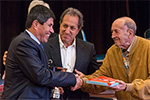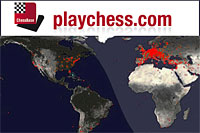 |
7th Continental Chess Tournament / Mar del Plata 2012
Tourney type: Eleven-round swiss open
Time control: 90 minutes for 40 moves followed by 30 minutes for the rest of the game and a 30 second increment as of move one.
Location: Mar del Plata, Argentina
Dates: October 12-21, 2012
Prizes: 1st - US$5000, 2nd -
US$3400, 3rd - US$2400, 20 prizes in all, not including prizes per category.
Special: Event is considered a world championship qualifier thus all norms earned are worth double.
|
Mar del Plata 2012 : The banana ate the monkey
Report and pictures by Albert Silver

The fountain in front of the playing venue as seen at night
In Brazil, there are a few expressions to describe situations where the least probable outcome takes place, and one of them translates to “the banana ate the monkey”. That is actually a very fitting description of the last couple of rounds at the 7th Continental, and in more ways than one.

The top boards in the penultimate round
Round ten
The tenth round had only one outright leader, Venezuelan GM Eduardo Iturrizaga, who was also playing extremely well. In a tournament, luck always plays a role, sometimes large, sometimes less, but here the 23-year-old was making his own, and it seemed like the event was now his. Facing strong Argentine GM Diego Flores, he drew as black and secured his place at the top for the last round. The American players had mixed results, with new GM-elect Hungaski getting outwitted by Peruvian legend Julio Granda Zuniga in a knight endgame, while Shabalov drew a normal game against Leitao. Gregory Kaidanov, who was on 7.0/9, a half point behind Iturrizaga, seemed headed to disaster and was a full piece down against Cuban GM Ortiz, but somehow swindled his way to a draw, a decisive turning point.

GM Gilberto Hernandez

GM Mekhitarian had to face Lazaro Bruzon, in round ten, a full 200-plus Elo above
Top seed Cuban GM Lazaro Bruzon had black against the event’s most visible dark horse, Brazilian GM Krikor Mekhitarian, and seemed like he was going to impose his strength as he headed toward a win. Things then took a very strange turn as they got into time trouble, and in a dramatic turning of the tables, he lost. Mekhitarian now shared sole lead with Iturrizaga, while Bruzon’s chances of qualifying were dependent on mathematical miracle in the last round. The banana had eaten the monkey.

An elated Krikor Mekhitarian is unable to stop grinning after his amazing swing
Round eleven
The eleventh round started relatively early the next day, at 10 AM, and the main lineup looked like this: Iturrizaga and Mekhitarian had 8.0/10, and were the surest bets to make it at least to the qualifier tiebreak (more on that in a second), followed by Ortiz, Felgaer, Granda Zuniga, Shabalov, Flores, Bacallao, Roselli, Kaidanov, and Hansen.
Though the players were fighting for the top prizes, the real prize was one of the four qualifying spots to the FIDE World Cup. Not only would this mean a door into the world championship cycle, but even a first round loss there would still mean an extra payday, not to mention the prestige garnered. In the event of a tie for any of the top four places in the tournament, such as six splitting fourth place, there would be a rapid round-robin tiebreaker. That is why, just a draw by either Iturrizaga or Mekhitarian guaranteed a part in this, while all the others at 7.5/10 obligatorily had to play for a win, since anything else would almost assuredly mean no chance.
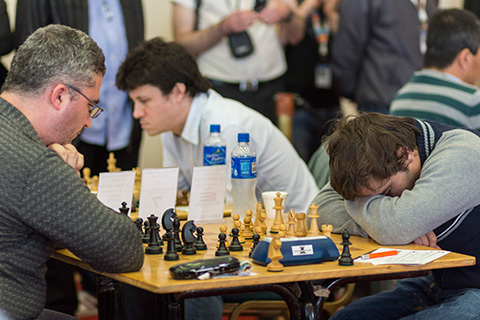
IM Alejo de Dovitiis encountered a 2700 GM who was barely able to keep his head up
during the entire game. Visibly the previous day's upset had led to excesses he was
having trouble recovering from.
Ortiz was quickly in trouble against an inspired Mareco, and there were no eleventh hour saves, while Shabalov scored a fairly clean win against Bacallao, making him the first to reach 8.5/11. The second result was quite a shocker though. Eduardo Iturrizaga, who had played splendidly until now, was white against the former goat-herder GM Julio Granda Zuniga. It is not for no reason that I labeled him semi-humorously as Julio “I never compromise” Granda Zuniga in a previous report. It is a reputation he has earned time and time again. Right in the opening, after a dozen symbolic opening moves, the Venezuelan offered Granda a draw. One almost wonders why he even bothered since he had to know that not only could the Peruvian not accept out of pure tournament considerations, but that this was the one opponent who scorned such things out of principle.
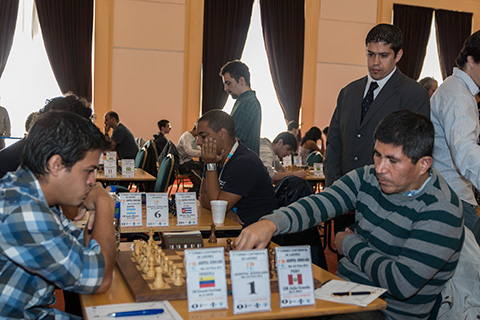
Iturrizaga found a typically belligerent Granda Zuniga in the last round. It is worth adding
that off the board Granda is a friendly as can be.
This was probably a psychological mistake, as he had to know his opponent would never accept, and should have instead prepared himself for a fight to the death. The result was that the Peruvian rose to the challenge once again, and went about completely outplaying his opponent, half his age, denying him his dream and making it his own.
The other leader, Krikor Mekhitarian, also met stormy conditions, and after a difficult game against Diego Flores, reached a rook endgame a pawn down, but with solid drawing chances, even if far from straightforward. Unfortunately for the Brazilian fans, he missed the correct path, and the Argentine scored a precious win for a ticket into the qualifying group.

A dismayed Mekhitarian stares at the difficult position he faces
Gregory Kaidanov’s game against Uruguayan IM Bernardo Roselli left no doubts that only one would be standing at the end. Both had three connected passed pawns, with a slew of pieces still, and peace was just not an option. When the smoke cleared, Kaidanov became the fourth to reach 8.5. If he were the last, the four players would all be guaranteed qualification… but one game was not over.
On table five, Ruben Felgaer, the hero of the Argentine team at the Istanbul Olympiad, was beating Canadian IM Eric Hansen, and a win would mean joining the four other winners and fighting for a spot. Though Felgaer's win was not in doubt, the 20-year-old continuously found resources to keep the game going just a bit longer, forcing the Argentine to constantly find the most precise continuation.
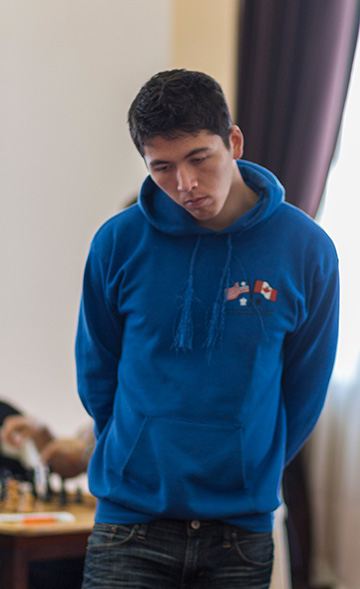
The ever restless Eric Hansen paces around
As time pressure loomed, Hansen’s tireless resistance wore him down, and not only did Felgaer’s advantage dissipate, but the tide turned and the miracle happened: Eric Hansen (2527 FIDE) became the unexpected fifth member to force a tiebreak tournament. The banana had eaten the monkey. Again.
The prize ceremony
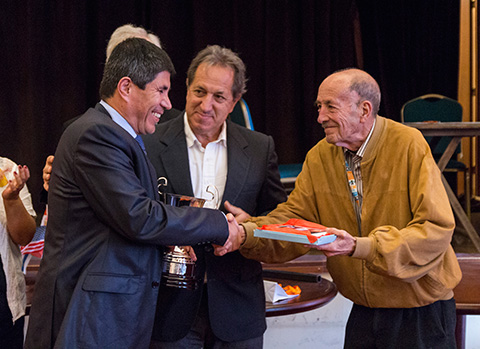
The prize ceremony actually took place before the tiebreaker. Julio Granda Zuniga was
the big winner, and here receives his trophy and prize from tournament director Mario
Petrucci and FIDE Continental president Jorge Vega.

The top four winners Julio Granda Zuniga, Diego Flores, Alexander Shabalov, and
Gregory Kaidanov. Eric Hansen was absent, and stayed in his hotel room preparing
for the forthcoming tiebreaks.
Tiebreak

Chief Arbiter Leandro Plotinsky (left) explains the tiebreak procedure and drawing of lots
The tiebreak took place the same day, at 6PM, and was to be a round robin between the five players at 15 minutes plus ten seconds increment. With five players playing for four spots, this also meant one player would have a bye each round. In the first round, both Americans Shabalov and Kaidanov were paired together, and a quick draw was the unsurprising result. On the second board, Julio Granda Zuniga faced Diego Flores in a KID Classic, and the Peruvian outplayed his opponent to start with a full point.

An imperial Granda Zuniga was the first to draw blood with a win over Flores in game one

Kaidanov helped secure his spot with a win over Hansen
It finally came down to the last round, by which point Julio Granda Zuniga was guaranteed a spot as were both American GMs Kaidanov and Shabalov. Argentine GM Diego Flores had 1.0/3 and Canadian IM Eric Hansen had 0.5/3, meaning that Hansen had a must-win situation with black, since even a draw meant he was out. Until then the 20-year-old’s play had been tense and tentative, which was completely at odds with his massive speed chess strength. Consider that the young IM has a colossal 3300 blitz rating in online chess, a stratospheric rating reserved until now only to 2700-rated grandmasters. He had been very tense due to the circumstances, and in his own words, was overthinking it.
As he later explained, with nothing to lose (his description), the tension lifted and he played at his most relaxed. He by no means rolled over Flores, but a late mistake by Diego when both were down to a minute, cost him the game, and Eric Hansen had pulled off the miracle, coming from behind and becoming the last and least expected qualifier.
The banana ate the monkey.
Final standings after eleven rounds
Live Broadcast
The top boards can be followed on Playchess live.
Event partners

Copyright
ChessBase
